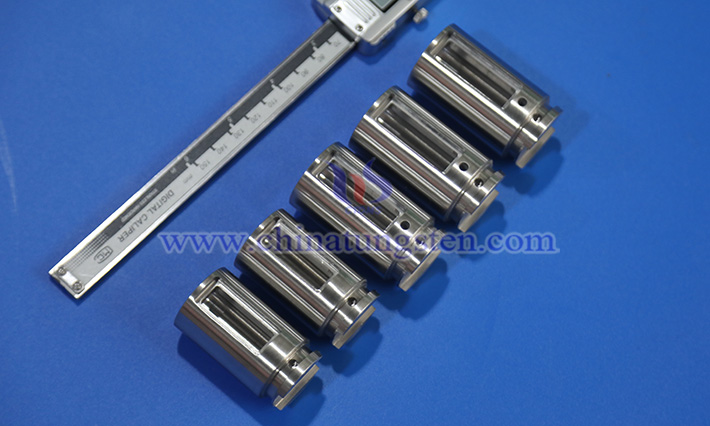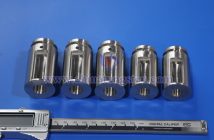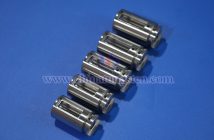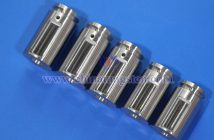In the era of rapid technological advancement, radiation has permeated fields such as medicine, research, and industry. In medicine, techniques like X-rays, CT scans, and radiotherapy provide robust support for disease diagnosis and treatment but also carry radiation risks. In research, experiments involving radioactive materials can threaten the health of scientists if mishandled or inadequately protected. In industry, radiation sources like nuclear power plants are widespread, and accidents could lead to radioactive material leaks, polluting soil, water, and air, causing long-term ecological damage. Facing these potential radiation threats, radiation protection is essential, with shielding materials playing a critical role. Among them, tungsten alloy shielding materials, with their unique advantages, are emerging as a new choice in radiation protection.
The tungsten alloy shielding can is a common type of tungsten alloy shielding component, a device designed to shield radioactive substances. It is widely used in medical, nuclear industry, and research fields, primarily to contain radioactive drugs or radionuclides, effectively preventing harm to surrounding personnel and the environment. In hospital radiotherapy departments, doctors use tungsten alloy shielding cans to store radioactive drugs, reducing radiation exposure to medical staff and patients during treatment. In research laboratories, when scientists conduct experiments involving radioactive materials, these cans are used for storage and transportation, ensuring a safe experimental environment.

I. Features of Tungsten Alloy Shielding Cans
Research indicates that a material's radiation protection ability is closely tied to its density—higher density generally correlates with better shielding performance. With a density of 16.5-18.75 g/cm3, tungsten alloy exhibits strong attenuation capabilities against gamma rays, effectively absorbing and blocking ray penetration, significantly reducing radiation intensity and providing a reliable protective barrier.
Compared to traditional lead shielding materials, tungsten alloy shielding cans offer distinct advantages. Lead, with a density of about 11.34 g/cm3, requires greater thickness to achieve the same shielding effect as tungsten alloy, increasing raw material consumption, raising overall costs, and posing challenges for transportation, installation, and daily operations due to its bulk—especially in space-constrained settings. In contrast, under equivalent shielding performance, tungsten alloy shielding cans can be thinner than lead counterparts.
With growing environmental awareness, a material's eco-friendliness is increasingly important. Tungsten alloy shielding cans excel in this aspect, being non-toxic and non-radioactive, posing no significant harm to human health or the environment during prolonged use.
Beyond excellent shielding and environmental benefits, tungsten alloy shielding cans boast superior mechanical properties. With high hardness and strength, they can withstand significant external impacts without deforming or damaging, and their good ductility allows for processing into various shapes and sizes to meet diverse needs.
In terms of corrosion resistance, tungsten alloy performs exceptionally. Whether in humid conditions or exposed to common chemical substances, these cans maintain stable performance, resisting corrosion that could reduce shielding effectiveness or shorten service life. This superior mechanical performance makes tungsten alloy shielding cans more durable than lead shielding materials, particularly suited for long-term use in complex, harsh environments. In the nuclear industry, where reactor interiors involve high temperatures, pressures, and corrosive media, tungsten alloy shielding cans operate reliably, ensuring safe facility operations. Lead shielding materials, however, are prone to damage in such conditions, failing to provide effective long-term protection.

II. Diverse Applications of Tungsten Alloy Shielding Cans
Thanks to their high density, strength, and excellent radiation shielding performance, tungsten alloy shielding cans shine across multiple fields.
In nuclear medicine, they are widely used to store and transport radioactive isotopes. The high density of tungsten alloy effectively shields gamma and X-rays, protecting medical staff and patients. For example, in positron emission tomography (PET) and radiotherapy, these cans safely store radioactive drugs like fluorine-18 tracers, ensuring radiation dose control while minimizing environmental leakage risks. Their corrosion resistance and mechanical stability also guarantee reliability over extended use.
In the nuclear industry, tungsten alloy shielding cans are employed in radioactive waste processing facilities to prevent leaks. Compared to lead shielding cans, they offer equivalent protection with smaller thickness or volume, providing stronger shielding in confined spaces. Their excellent high-temperature stability and corrosion resistance make them ideal for the long-term storage and transport of nuclear waste.
In high-energy physics experiments and radioactive isotope research, tungsten alloy shielding cans are a standard radiation protection device. In particle accelerator experiments, their high density effectively attenuates X-rays, gamma rays, and secondary particle beams. In synchrotron radiation or spallation neutron source facilities, they isolate instantaneous radiation from high-energy electron beam collisions with targets, preventing interference with detector signals or harm to experimenters. In nuclear physics labs, these cans are used to store or handle highly active radioactive samples like plutonium-239 and uranium-235 over short or long periods.
In military applications, tungsten alloy shielding cans protect equipment and personnel from radioactive threats. For instance, in nuclear, biological, and chemical (NBC) protection gear, they are used to create portable shielding containers for storing or transporting radioactive materials. Additionally, their non-magnetic properties make them suitable for electromagnetic-sensitive equipment, broadening their use in defense technology.



